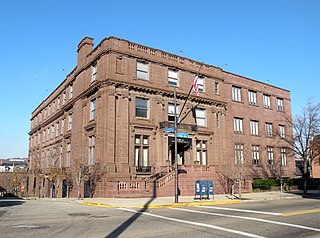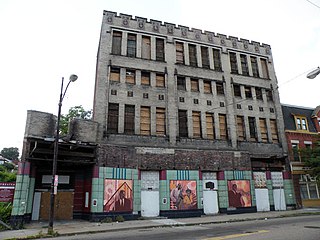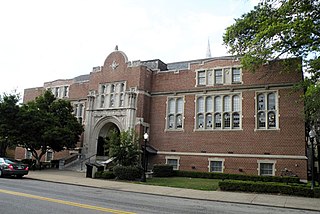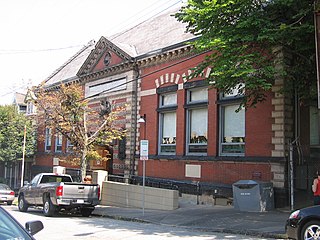
Allegheny West is a historic neighborhood in Pittsburgh, Pennsylvania's North Side. It has two zip codes of both 15233 and 15212, and has representation on Pittsburgh City Council by the council member for District 1.

This is a list of the National Register of Historic Places listings in Allegheny County, Pennsylvania.

The Children's Museum of Pittsburgh is a hands-on interactive children's museum in Pittsburgh, Pennsylvania. It is in the Allegheny Center neighborhood in Pittsburgh's Northside.

The following properties are listed on the National Register of Historic Places in Pittsburgh, Pennsylvania.
Pittsburgh landmarks can refer to either of two types of Pittsburgh landmark designations:

The Byers-Lyons House in the Allegheny West neighborhood of Pittsburgh, Pennsylvania, is a building from 1898. It was added to the List of City of Pittsburgh historic designations on March 15, 1974, the National Register of Historic Places on November 19, 1974, and the List of Pittsburgh History and Landmarks Foundation Historic Landmarks in 1989.

The William Penn Snyder House in the Allegheny West neighborhood of Pittsburgh, Pennsylvania was built in 1911. It was added to the List of Pittsburgh History and Landmarks Foundation Historic Landmarks in 1972, the List of City of Pittsburgh historic designations on March 15, 1974, and the National Register of Historic Places on May 3, 1976. Babb, Inc., an insurance brokerage firm currently owns and occupies the building.

The B. F. Jones House at 808 Ridge Avenue in the Allegheny West neighborhood of Pittsburgh, Pennsylvania, was built from 1908 to 1910. When it was completed, it had 42 rooms and cost $375,000 to build. It was once the home of Benjamin Franklin Jones Jr., the son of Benjamin Franklin Jones, a founder of the Jones and Laughlin Steel Company. It is currently Jones Hall of the Community College of Allegheny County.

The New Granada Theater at 2007 Centre Avenue in the Hill District neighborhood of Pittsburgh, Pennsylvania, was built in 1927 and 1928. This Art Deco theater was designed by architect Louis Arnett Stuart Bellinger, and originally was a Pythian Temple, a meeting place for the Knights of Pythias. In this case, it was a lodge for a group of African American construction workers known as the Knights of the Pythian. In the 1930s, the building was sold to Harry Hendel, who moved two blocks from his old Granada Theater to this New Granada Theater. The building was remodeled in 1937 and 1938 by Alfred M. Marks, and it became a movie theater as well as a place for live entertainment, music and dancing. Jazz legends such as Duke Ellington, Ella Fitzgerald, Count Basie and Cab Calloway performed at this location.

The Homewood Branch of the Carnegie Library of Pittsburgh is a library in Pittsburgh, Pennsylvania. It is located at 7101 Hamilton Avenue in the Homewood South neighborhood and opened on March 10, 1910. It was designed by the architectural firm Alden & Harlow, and it was added to the List of City of Pittsburgh historic designations on July 28, 2004, and the List of Pittsburgh History and Landmarks Foundation Historic Landmarks in 2004. This library was featured in an episode of Mister Rogers' Neighborhood.

The Lawrenceville Branch of the Carnegie Library of Pittsburgh, located at 279 Fisk Street in the Lawrenceville neighborhood of Pittsburgh, Pennsylvania, opened May 10, 1898. It was originally commissioned as part of Andrew Carnegie's first grant to Pittsburgh and was the second library in the Pittsburgh city system to open, following the Main Branch.

The Mount Washington Branch of the Carnegie Library of Pittsburgh located at 315 Grandview Avenue in the Mount Washington neighborhood of Pittsburgh, Pennsylvania, was built in 1900. It was designed by the architectural firm Alden & Harlow, and it was added to the List of City of Pittsburgh historic designations on July 28, 2004 and the List of Pittsburgh History and Landmarks Foundation Historic Landmarks in 1989.

The old Allegheny County Jail in downtown Pittsburgh, Pennsylvania is part of a complex designed by H. H. Richardson. The buildings are considered among the finest examples of the Romanesque Revival style for which Richardson is well known.

Saint Nicholas Croatian Catholic Church was a Roman Catholic church located at 1326 East Ohio Street in the Troy Hill neighborhood of Pittsburgh, Pennsylvania. The Croatian Catholic parish of St. Nicholas was established in 1894 as the first Croatian Catholic parish in the United States, in the city of Allegheny, now Pittsburgh's North Shore.

The King Estate located at 5501 Elgin Street in the Highland Park neighborhood of Pittsburgh, Pennsylvania, was built in 1880. Alexander King was the original owner of this Second Empire style house. It was added to the List of City of Pittsburgh historic designations on November 12, 1992, and the List of Pittsburgh History and Landmarks Foundation Historic Landmarks in 2000.

Thaddeus Stevens Elementary School located at 824 Crucible Street in the Elliott neighborhood of Pittsburgh, Pennsylvania, was built in 1939. It was a part of Pittsburgh Public Schools and served Elliott, Esplen, Sheraden, West End, and Westgate Village.

Saint Michael's Roman Catholic Church & Rectory is a former Roman Catholic church and rectory located at 21 Pius Street in the South Side Slopes neighborhood of Pittsburgh, Pennsylvania. The church was built from 1855 to 1861 and designed in Romanesque Revival style by architect Charles Bartberger (1824–1896). The rectory behind the church was built in 1890 and designed in Richardsonian Romanesque style by architect Frederick C. Sauer (1860–1942). Both the church and the rectory were added to the List of City of Pittsburgh historic designations on February 23, 2001, and the church was added to the List of Pittsburgh History and Landmarks Foundation Historic Landmarks in 1970.

Mellon National Bank Building at 514 Smithfield Street in downtown Pittsburgh, Pennsylvania, was completed in 1924 after Mellon acquired the property in August 1916 from the Baltimore & Ohio Railroad which had their regional offices on the site. Prior to the B&O office the site was the original home to the city's first public high school which opened in the fall of 1855. The Classical styled building was designed by architects Trowbridge & Livingston with Edward Mellon. It was added to the List of Pittsburgh History and Landmarks Foundation Historic Landmarks in 1976, and the List of City of Pittsburgh historic designations in July 1999.



















